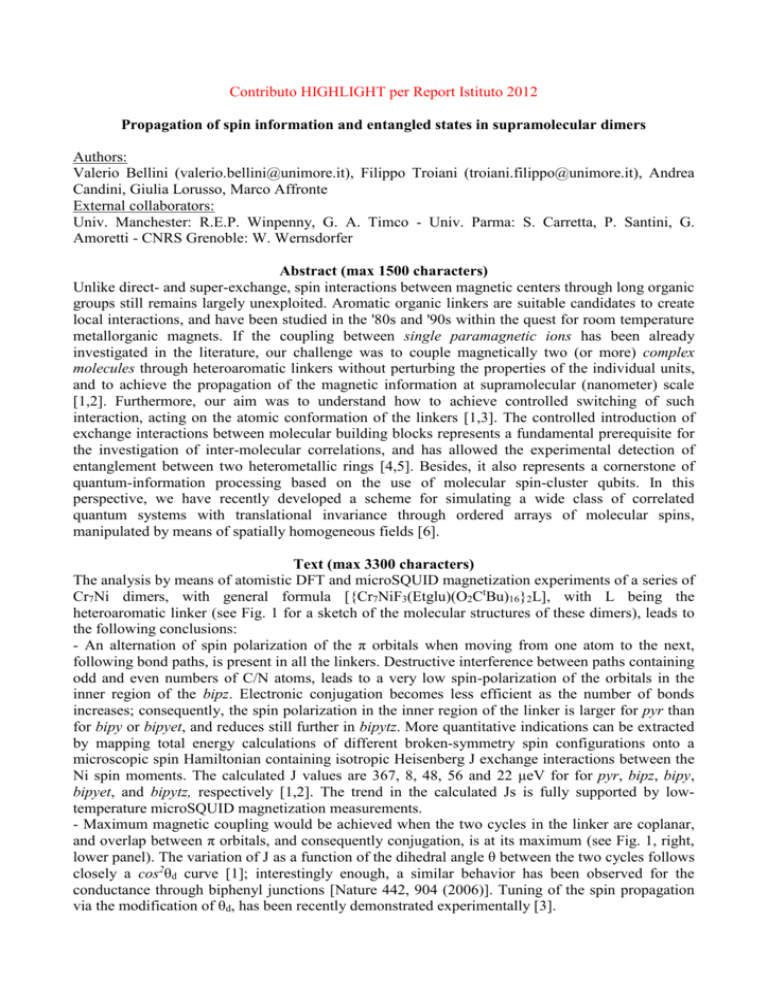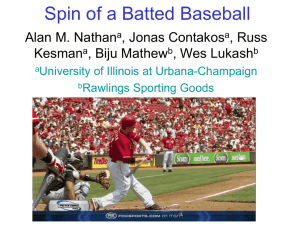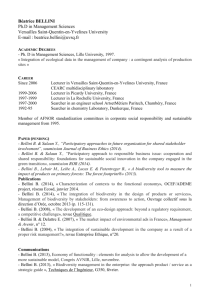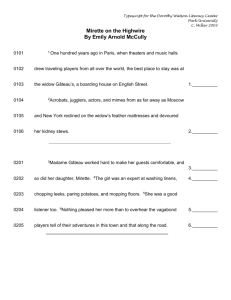Contributo HIGHLIGHT per Report Istituto 2012 Propagation of spin
advertisement

Contributo HIGHLIGHT per Report Istituto 2012
Propagation of spin information and entangled states in supramolecular dimers
Authors:
Valerio Bellini (valerio.bellini@unimore.it), Filippo Troiani (troiani.filippo@unimore.it), Andrea
Candini, Giulia Lorusso, Marco Affronte
External collaborators:
Univ. Manchester: R.E.P. Winpenny, G. A. Timco - Univ. Parma: S. Carretta, P. Santini, G.
Amoretti - CNRS Grenoble: W. Wernsdorfer
Abstract (max 1500 characters)
Unlike direct- and super-exchange, spin interactions between magnetic centers through long organic
groups still remains largely unexploited. Aromatic organic linkers are suitable candidates to create
local interactions, and have been studied in the '80s and '90s within the quest for room temperature
metallorganic magnets. If the coupling between single paramagnetic ions has been already
investigated in the literature, our challenge was to couple magnetically two (or more) complex
molecules through heteroaromatic linkers without perturbing the properties of the individual units,
and to achieve the propagation of the magnetic information at supramolecular (nanometer) scale
[1,2]. Furthermore, our aim was to understand how to achieve controlled switching of such
interaction, acting on the atomic conformation of the linkers [1,3]. The controlled introduction of
exchange interactions between molecular building blocks represents a fundamental prerequisite for
the investigation of inter-molecular correlations, and has allowed the experimental detection of
entanglement between two heterometallic rings [4,5]. Besides, it also represents a cornerstone of
quantum-information processing based on the use of molecular spin-cluster qubits. In this
perspective, we have recently developed a scheme for simulating a wide class of correlated
quantum systems with translational invariance through ordered arrays of molecular spins,
manipulated by means of spatially homogeneous fields [6].
Text (max 3300 characters)
The analysis by means of atomistic DFT and microSQUID magnetization experiments of a series of
Cr7Ni dimers, with general formula [{Cr7NiF3(Etglu)(O2CtBu)16}2L], with L being the
heteroaromatic linker (see Fig. 1 for a sketch of the molecular structures of these dimers), leads to
the following conclusions:
- An alternation of spin polarization of the π orbitals when moving from one atom to the next,
following bond paths, is present in all the linkers. Destructive interference between paths containing
odd and even numbers of C/N atoms, leads to a very low spin-polarization of the orbitals in the
inner region of the bipz. Electronic conjugation becomes less efficient as the number of bonds
increases; consequently, the spin polarization in the inner region of the linker is larger for pyr than
for bipy or bipyet, and reduces still further in bipytz. More quantitative indications can be extracted
by mapping total energy calculations of different broken-symmetry spin configurations onto a
microscopic spin Hamiltonian containing isotropic Heisenberg J exchange interactions between the
Ni spin moments. The calculated J values are 367, 8, 48, 56 and 22 μeV for for pyr, bipz, bipy,
bipyet, and bipytz, respectively [1,2]. The trend in the calculated Js is fully supported by lowtemperature microSQUID magnetization measurements.
- Maximum magnetic coupling would be achieved when the two cycles in the linker are coplanar,
and overlap between π orbitals, and consequently conjugation, is at its maximum (see Fig. 1, right,
lower panel). The variation of J as a function of the dihedral angle θ between the two cycles follows
closely a cos2θd curve [1]; interestingly enough, a similar behavior has been observed for the
conductance through biphenyl junctions [Nature 442, 904 (2006)]. Tuning of the spin propagation
via the modification of θd, has been recently demonstrated experimentally [3].
The control of intermolecular exchange between pairs of heterometallic rings can be exploited in
order to observe quantum entanglement between complex molecules and to manipulate quantum
information encoded in molecular spin-cluster qubits. In the first case, an antiferromagnetic
coupling J between two heterometallic rings has allowed to detect equilibrium-state entanglement
between them, through the use of magnetic susceptibility as an entanglement witness. Here, the
required J (about 40 mK) was smaller than the exchange coupling between ions within each ring but
larger than the temperature at which the susceptibility measurements could be performed [4]. The
fine tuning of intermolecular exchange interactions can also represent a crucial resource in quantum
simulation based on the use of molecular spin qubits [5]. In particular, we have recently developed
a scheme for simulating prototypical quantum Hamiltonians with translational invariance in arrays
of molecular qubits, manipulated by means of spatially homogeneous fields. In the proposed
scheme, the magnetic molecules play two distinct roles: (effective) two-level systems are used to
encode the qubits; dimers (or oligomers) mediate the coupling between the qubits, and allow to
switch it on and off if suitably driven from a non-magnetic to a magnetic state, or viceversa [6].
Figure 1 (left) The molecular structures of Cr7Ni dimers. The atoms of the linkers (N, blue; C, gray; H, white) and the
metal ions in the rings (Ni, yellow; Cr, green) are highlighted; the inter-rings through-space Ni-Ni distances (d) are
also given for each dimer; (right) a) Total energy and b) exchange interaction parameter J in the bipy-linked dimers,
as a function of the dihedral angle θd between the two pyridine cycles.
References
[1] V. Bellini, G. Lorusso, A. Candini, W. Wernsdorfer, T. B. Faust, G. A. Timco, R.E.P.
Winpenny, and M. Affronte, “Propagation of spin information at supra-molecular scale through
hetero-aromatic linkers”, Phys. Rev. Lett. 106, 227205 (2011). Selected as Editors’ Suggestion.
[2] Th. B. Faust, V. Bellini, A. Candini, S. Carretta, L. Carthy, B. J. Coe, D. Collison, R. J.
Docherty, J. Kenyon, G. Lorusso, J. Machin, E. J. L. McInnes, C. A. Muryn, R. G. Pritchard, S. J.
Teat, G. A. Timco, F. Tuna, G. F. Whitehead, W. Wernsdorfer, M. Affronte and R. E. P. Winpenny,
“Chemical control of spin propagation between heterometallic rings”, Chem.-Eur. J. 17, 14020
(2011).
[3] Th. B. Faust, F. Tuna, G. A. Timco, V. Bellini, M. Affronte, W. Wernsdorfer, and R. E. P.
Winpenny, “Twist and shout – magnetic communication through aromatic bridges with different
torsion angles”, To be submitted to Chemical Science (2012).
[4] F. Troiani, V. Bellini, A. Candini, G. Lorusso, and M. Affronte, “Spin entanglement in
supramolecular structures”, Nanotechnology 21, 274009 (2010).
[5] F. Troiani and M. Affronte, “Molecular Spins for Quantum Information Technologies”, Chem.
Soc. Rev. 40, 3119 (2011).
[6] P. Santini, S. Carretta, F. Troiani, and G. Amoretti, “Molecular Nanomagnets as Quantum
Simulators”, Phys. Rev. Lett. 107, 230502 (2011).










